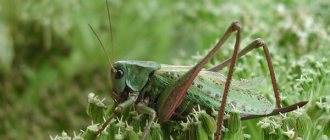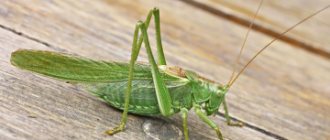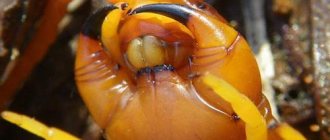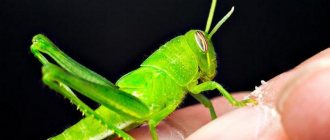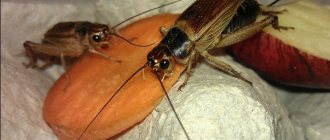Singing grasshopper keeping a home
Many people may think that the singing grasshopper is an excellent pet to keep at home, but actually they are right.
If you are not bothered by the fact that the pet will not live long, and will chirp without a female in a pair, then feel free to drag it home. It is not difficult to make a terrarium for a song grasshopper; any container with sufficient ventilation, approximately 40x30x30 in size for 2-3 song grasshoppers, will do. Read how to make an insectarium with your own hands. Information about the amount of space required was taken from the Internet; at home I kept them in spartan conditions, about 5-6 individuals in a 12-liter aquarium in a vertical orientation, gradually feeding them to the spider.
It is recommended to sprinkle sawdust at the bottom of the container, and place a jar of wet peat in the corner, into which the female will lay larvae. I think any substrate will do, even soil from the street, with the proviso that you will then have to look for the eggs of the singing grasshopper by hand. You should also place various driftwood and sticks in the container to increase the usable area and allow the grasshopper to climb branches.
The singing grasshopper should be fed with insects; at home, you can feed it with food insects such as marbled cockroaches or Turkmen cockroaches; you should also offer greens in the form of various plants from the street.
Song grasshopper eggs along with the substrate should be removed at the end of August and placed in the refrigerator until the end of February. Then they are removed and the little singing grasshoppers are waited for to emerge.
I hope you liked the article and it was informative; you can see photographs of other insects in Russia in the special
Feeding the crickets
In the wild, the cricket feeds on pieces of plants, small insects, and dead arthropods. Some individuals do not disdain cannibalism and destruction of the clutches of their relatives. But what to feed crickets at home?
When kept in captivity, the following is suitable food for crickets:
- finely chopped vegetables and fruits;
- greens, tops, burdock and dandelion leaves;
- milk in powder form, including infant formula;
- oatmeal and bran;
- food for cats and dogs;
- boiled chicken egg;
- boiled lean meat.
A very important component of a cricket's diet is protein. If there is not enough of it, the insects will begin to eat each other. Females that feed only on plant foods lay eggs that will soon die. And the life expectancy of adults will be much shorter. Therefore, it is necessary to add fishmeal, egg whites and gammarus, which is used to feed aquarium fish.
Dry food should be freely available at all times. It is recommended to give wet foods in portions, 1–2 times a day. This will help prevent rotting and bacterial growth.
How to water crickets? Some experts suggest installing a drinking bowl, but this is not entirely safe: young individuals drown in them, females lay eggs, and it’s quite easy to turn it over. Another option - spraying one corner with a spray bottle - entails a persistent increase in humidity, and, as a result, the appearance of mites. Therefore, to save yourself from problems, you just need to give enough juicy and wet food, forgetting about drinking bowls and spraying. But we should not forget: lack of moisture will lead to death or cannibalism.
What do grasshoppers eat?
Grasshoppers belong to the order Orthoptera of the class of insects. In total, there are about 7 thousand species of these creatures in the world. And like many other ubiquitous animals, grasshoppers are not exclusive to Antarctica.
I personally am used to seeing very small grasshoppers no more than 5 cm long. However, I read that there are species that reach a length of about 15 cm.
These creatures have 6 legs, three on each side. If they use the first two pairs only for walking, then with the help of the rear ones they jump to the distances that we are used to seeing. They are 20 times the length of his body.
Now the most important thing is that grasshoppers eat the meat of other insects. These could be mosquitoes, flies, bugs and some other animals. In some cases, a grasshopper's hunt may not be successful. Then he does not disdain plant foods. Moreover, unlike locusts, grasshoppers do not eat cultivated plants on farms. Rather, on the contrary, they help people fight, for example, Colorado potato beetles.
Here is a small selection of interesting facts about these unusual creatures:
- The chirping we hear from grasshoppers is produced exclusively by males. Females are not able to make these sounds.
- And what would we do without this fact, which I have known about for probably a million years. The auditory analyzer in grasshoppers is not on the head, but on the front legs.
- The maturation of grasshoppers is similar to that of the Spartans. In order for a boy to become a man, the Spartans sent him to wander into the forest, where he had to survive. In grasshoppers, only one individual out of ten manages to pass the larval stage, since not all of them can get out of the ground. Only the best of the best.
If you go out into the field in warm weather, you can almost always hear the chirping of grasshoppers even before you see them. This is an amazing and unusual insect. Jumpers belong to the order Orthoptera. There are more than 7 thousand different species of these insects in the world.
Menu
What grasshoppers feed on crops harms farmers. They love to eat grape buds and flowers. Did you know that the grasshopper is primarily nocturnal? But during the day he hides in secluded places, and comes out to hunt only at dusk. By the way, he is not such a harmless insect. In nature, grasshoppers are actually predators. And although their diet includes plant foods, the main menu consists of small butterflies, mites, and caterpillars. Hiding in ambush, the grasshopper waits for prey and with its powerful paws that are in front, grabs the victim. Then the “hunter”, using strong jaws, shreds the caught insect and then eats it. The size of the prey matters; the victim should not be larger than the “hunter”. Grasshoppers, cannibals, do not exclude their small brothers, as well as their larvae, from their menu. They are not gourmets, so they eat everything that comes their way. As it turned out, plant and animal food is what grasshoppers eat.
Another very interesting fact. If you think that everything that jumps green or gray at you when you walk on the grass is grasshoppers, then no. They are often confused with fillies or representatives of the Locust family. He himself hid in a shelter and quietly dozed.
The life of grasshoppers is very short-lived, about one year, including the larvae.
Features of character and lifestyle
Photo: Large grasshopper
Grasshoppers are most active during the day but feed at night. They do not have nests or territories, and some species go on long migrations to find new food supplies. Most species are solitary and come together only to mate, but migratory species sometimes gather in huge groups of millions or even billions of individuals.
Fun Fact: When a grasshopper is picked up, it "spits" a brown liquid known as "tobacco juice." Some scientists believe that this liquid can protect grasshoppers from attacks by insects such as ants and other predators - they "spit" the liquid on them, and then catapult and quickly fly away.
Grasshoppers also try to escape from their enemies hiding in the grass or among the leaves. If you've ever tried to catch grasshoppers in a field, you know how quickly they can disappear into the long grass.
The locust is a type of grasshopper. They are big and strong fliers. Sometimes their populations explode and they travel in huge swarms in search of food, causing enormous damage to the crops that man has grown for them. There are several species of locust in the Middle East that reach Europe, and migratory locusts (Locusta migratoria) are found in northern Europe, although they do not often accumulate in huge numbers there.
How does a grasshopper live?
The lifestyle directly depends on the type of grasshopper and its characteristic features.
A common green grasshopper has a body length of up to 4 mm. This is believed to be the most common group.
As for orange grasshoppers, they were brought to us from China. You can only see them in greenhouses.
The largest grasshopper is considered to be the Giant Weta. It weighs about 80 grams.
Grasshoppers are not pests for humans and agricultural land. And some peoples have long included these insects in their daily diet.
If a grasshopper feels threatened by a person, it may bite him. The bites received from this insect are quite painful, because it has a powerful jaw.
Some people like the grasshopper's singing, and in order to continue to listen to it constantly, people have come up with an artificial habitat for maintaining a home - insectariums.
Features of behavior and lifestyle
Have you noticed that grasshoppers begin to actively chirp after dark? These jumpers are nocturnal, unlike the same locusts. During the day, these insects rest, becoming easy prey for predators. To help them survive, nature provided grasshoppers with colors that match the color of grass and leaves.
While on the plant, the insect matches it in color, which gives it a chance to go unnoticed and uneaten. Most species even have peculiar veins on their wings, which further increases the similarity of the grasshopper to a green leaf. If the predator nevertheless notices the prey and approaches, the jumper spreads its hind wings with eyes and makes a jump towards it, which for some time plunges the enemy into shock and amazement. This second is enough for the grasshopper to quickly disappear into the nearby thickets.
These green jumpers are loners. They do not have a permanent home and do not create burrows. They spend all day jumping among the grass and bushes, hunting for prey. Why do these insects chirp? This singing has two tasks: they try to attract a female and inform other males that the territory is already occupied, so they better look for another place.
Lifestyle
These insects prefer solitude. Those who are trying to figure out how long grasshoppers live will do well to understand that they do not have their own home. They live among trees and bushes. In particularly hot weather, insects hide in the grass all day, leaving shady shelters in the morning.
Throughout the summer, grasshoppers produce ringing melodies. These sounds are the result of vibration. They intensify when the insects raise their wings. The singing of males allows them to attract the attention of females and show rivals that the given territory is already occupied.
Such different grasshoppers
More than 6,800 representatives of grasshoppers live on the globe. They are able to live everywhere except Antarctica, and a flexible food system plays an important role in this.
Some of them are examples of perfect camouflage. In the photo below is the quest “Find the grasshopper”:
Today I would like to talk about such a frequently encountered insect as the singing grasshopper; everyone has probably heard the “singing” of grasshoppers thousands of times, this chirping that begins to be heard with the onset of evening and sometimes does not stop until the middle of the night. I am sure that many people know where this chirping comes from, it is a male grasshopper calling for a female. But what else do we know about this insect? Let me tell you about the singing grasshopper in a little more detail.
Adult grasshopper
By mid-summer, the larva molts for the last time and becomes an elegant winged insect. In hot weather, grasshoppers mostly sit motionless, with their front legs extended. This is very reminiscent of the posture of their close relative, the praying mantis. Like the praying mantis, the grasshopper has grasping spines on the inner surface of its front legs, albeit small ones. If a hunter comes across a careless filly, the blacksmith quickly deals with it with a bite to the back of the head, eats it, leaving only the head and wings, and freezes again.
Males sometimes emit separate trills to attract females, but the main courtship takes place in the second half of the night. The song produced by a green grasshopper resembles striking metal, sounding very quietly, as if in the distance. This is why the insect got its name.
At dawn, the activity of grasshoppers increases. Diurnal insects, as a rule, are poorly oriented in the dark. The grasshopper is helped by long mustaches and sensitive hearing organs located on the front legs. Some fillies are twice the size of a farrier, but a powerful bite to the back of the head immobilizes any of them. Even cicadas that fly well cannot escape. In areas with sandy soil there is even more nourishing food - young beetles. The mass emergence of these beetles occurs at night, and many of them, upon reaching the surface, immediately become prey.
The tendency towards predation is mainly shown by females, and males have a sweet tooth. Fruits that have fallen to the ground are a real delicacy for them; the strongest individual does not allow competitors to approach the food, driving them away with blows of its hind legs. If you are unlucky in the hunt, the grasshopper is content with vegetation. Thus, this insect can be called an omnivore.
In a number of Asian countries, the grasshopper is considered a popular pet, along with the cricket. Pleasant sounds are produced by males of the species Tettigonia cantans (singing grasshopper) and some others. Chinese breeders have even developed several breeds that sing differently than their wild ancestors. The price of a particularly “euphonious” grasshopper reaches $20.
Middle zone grasshoppers can also be kept at home. Their food is lettuce leaves, unripe ears of wild cereals, berries, pieces of apples, pears and other fruits. Beetles, small locusts and other living creatures will be eaten at night, but if the grasshoppers are hungry, the hunt will take place at any time of the day. When the time comes for females to lay eggs, it is better to lay them one at a time, otherwise the struggle for territory will lead to fights and cannibalism. And the males will live peacefully with each other and chirp until the fall.
Grasshoppers in an aquarium
Briefly: Watching grasshoppers is interesting, and it’s more convenient to do it at home. How to keep grasshoppers at home is in our article.
Home > Animals > Aquarium pets
Good in summer! The sun warms generously, the grass in the meadows has risen and is full of different colors. On a hot day, the grasses ring with the cheerful chirping of grasshoppers. Sounds either come from afar or appear right under your feet. Sit down and look closely. Do you see at least one singer? No. Its green color with brown spots camouflages it so much that, remaining motionless, it becomes as if invisible.
Isn't it interesting to get to know these summer musicians better and find out how they sing? It's easy to do. Grasshoppers live well in captivity, and the secrets of their short lives are not difficult for a careful observer to discover.
First of all, take care of a suitable room. You can make a fish tank out of a large parcel box. Make the front wall glass (reinforce the glass with slats so that you can lift it and clean the fish tank), and cut large windows in the back and side walls and cover them with fine mesh or gauze. Pour sand into a layer of 3-4 centimeters at the bottom, plant grass bushes in the corners (dig along with roots and soil). It would be nice to attach a thick branch to the wall of the cage - grasshoppers willingly climb higher when the sun warms up. An aquarium can also be used as a fish tank.
The house is ready - you can go get the residents. If you manage to cover the captive, carefully pick it up by its two hind legs (if it comes off by one, it will come off), and transfer it to a jar of grass. Very quickly you will get the hang of it and be able to catch as many of them as you like, but you don’t need more than seven or eight. There should be both males and females among them. Females can be distinguished by the long, curved ovipositor protruding from the end of the abdomen,
The most widespread are green and gray grasshoppers; the songbird and tailed grasshopper also live in the European part. In the Ussuri region, in the area of mixed and deciduous forests, the Ussuri green grasshopper lives. Their lifestyle is largely similar; in captivity they require the same care. Grasshoppers need to be fed with both plant food - ears of rye, barley, wheat, lettuce leaves, slices of carrots, potatoes, apples, and animal food - fillies, caterpillars and other insects that are smaller than grasshoppers should be allowed into the cage. Be sure to spray the cage with water in the morning and don’t forget to water the grass.
There is no need to catch large steppe grasshoppers. There are very few of them left in nature.
If the cage is illuminated by the sun, if there is fresh grass and enough food in it, the grasshoppers will feel great and will be able to live in captivity throughout their short lives.
When the sun warms up the cage, the males begin their concert. The musicians recline, rhythmically striking one elytra against the other. This is where the sound apparatus is located. At the base of the right elytra there is a so-called “mirror” in the form of a round thin transparent membrane surrounded by a vein that forms a frame. There is also a “mirror” on the left elytra, but it is opaque and dense. The vein surrounding it is thick and equipped with small teeth. This vein acts as a bow, and the “mirror” serves as a resonator when chirping. The hearing aid is located on the lower leg of the front legs. On both sides of the lower leg there are two oval membranes that act as eardrums. The internal part of the hearing aid has a complex structure - there are nerve endings, sensory cells, muscles, and a branch of the trachea approaches each of the membranes. Due to the air pressure in the trachea, the membranes are always tense.
Like birdsong, grasshoppers' chirping is a way to attract the attention of a female.
In the second half of August, after laying eggs, the life of grasshoppers comes to an end. They move more and more sluggishly, their long strong legs begin to fall off. At the end of August–September, all grasshoppers die.
Is it a grasshopper?
We are used to thinking that if a small insect chirps and jumps, then it is probably a grasshopper. But that's not true. There is an insect similar to a grasshopper, for example, a grasshopper or a cricket. And all because they form a single group of insects called Orthoptera. Fillies, like grasshoppers, have two pairs of perfectly developed wings and powerful hind legs. But there are also serious differences between these representatives of the insect world. In fillies, the antennae are directed forward and short, while in grasshoppers they are long, almost like the insect itself, thin and pointing back. The ears of fillies are located on the sides of the body, and in grasshoppers they are located on the front legs. And the main difference is lifestyle and diet. We found out what grasshoppers eat and that they are nocturnal insects. But, unlike them, fillies lead a diurnal, active lifestyle, and their diet consists only of plant foods.
It is worth mentioning the cricket, which is sometimes mistaken for a grasshopper. And this is not surprising, they are very similar. They have the same long antennae, and their chirping organs are arranged in the same way. But in crickets they are larger in size and more complex in structure. And this is not surprising; many have heard him chirp melodiously. During the day, crickets, like grasshoppers, sit out in secluded dark places, so they are not often seen. But when dusk sets in, they will definitely make themselves known with their ringing melody. They are predators, need food rich in protein, and do not disdain small crickets. But if he lives at your house, he can eat scraps from your table.
The singer of a sunny day, the most harmless creature of all the inhabitants of the summer meadow... Since childhood, everyone has been convinced that grasshoppers eat only grass. A typical misconception of people unfamiliar with the lifestyle and customs of this insect
It is enough to carelessly pick up a grasshopper and a noticeable bite, sometimes drawing blood, is guaranteed. Some species have a downright bulldog grip: an attempt to free oneself from a clinging blacksmith results in the head remaining on the skin, and its jaws can only be opened with a penknife... The ancient Greeks called them “decticus”, i.e.
e. "biting". Why do peaceful herbivores need such weapons?
Taxonomy [edit | edit code ]
The following subfamilies are distinguished in the grasshopper family:
The singer of a sunny day, the most harmless creature of all the inhabitants of the summer meadow... Since childhood, everyone has been convinced that grasshoppers eat only grass. A typical misconception of people who are not familiar with the lifestyle and customs of this insect. It is enough to carelessly pick up a grasshopper and a noticeable bite, sometimes drawing blood, is guaranteed. Some species have a downright bulldog grip: an attempt to free themselves from a clinging blacksmith results in the head remaining on the skin, and its jaws can only be opened with a penknife... The ancient Greeks called them “decticus”, i.e. “biting”. Why do peaceful herbivores need such weapons?
Structure
External characteristics of the grasshopper:
- Flattened body on both sides
- Head with big eyes
- 3 pairs of legs,
- Wings.
They move with the help of their front legs, and with the help of their more muscular hind legs, insects jump quite long distances. The length of the jump is 20 times greater than the insect's body.
The length of a grasshopper depends on the species and ranges from 1 to 5 cm, but there are some individuals whose size reaches 15 cm. Which is comparable to the length of a praying mantis.
The whiskers serve as the insect's sense of touch. An interesting fact is that the longer the length of the antennae, the higher the higher place the grasshopper occupies on the hierarchical ladder among its relatives.
The wings have a direct function and help the grasshopper take off and fly short distances.
Some subspecies have an additional pair of wings that perform a protective or safety function for the main wings.
Larva
Grasshoppers are insects with incomplete metamorphosis, that is, their larva resembles a smaller copy of the adult, only without wings. The ancient genus of Orthoptera has reached our days from distant times, when the coal seams were formed, and has not changed at all since then.
The life of a green grasshopper does not begin in a meadow, but in the soil, at a depth of about 5-7 centimeters. There the insect emerges from the egg and begins the difficult journey towards the sun. The first instar larva (that is, before the first molt) is half a centimeter in size and is dressed in a whitish case that fits tightly, with a bubble in the back of the head. Moving like a worm, it moves upward, and the bubble, swelling and falling, serves to push apart the soil particles. Having encountered a stone on the way, the larva is doomed, because it can only move in a straight line. There are about 60 eggs in the clutch, but only the strongest and luckiest, about 10%, come to the top.
At the top, the insect takes off its temporary “space suit.” After waiting a little for the chitinous covers to harden under the sun, the larva begins to feed. She prefers the most tender parts of the leaves. During the season, the insect molts several times, increasing in size until it reaches the adult stage. As the larva grows, its menu also undergoes changes.
In middle age, the basis of the diet consists of grass seeds in the stage of milky ripeness, but the young grasshopper already shows predatory tendencies, destroying clumsy aphids and clutches of other insects encountered along the way. Hairless caterpillars are readily eaten. Gradually, the jaws become stronger, and older larvae easily cope with small locusts.
Anatomy of a grasshopper
The grasshopper has an oblong body, ranging in size from 1.5 to 15 cm in length, depending on the type of insect. Its body is conventionally divided into three sections: head, chest and abdomen. The grasshopper has two pairs of wings - front and rear, with the help of which it rises into the air and flies short distances. The grasshopper's head is large with very long antennae, which sometimes exceed the length of its body and are the insect's organ of touch. The eyes are large. The color of a grasshopper also depends on its habitat; it can be green, brown or even striped. Females are larger than males.
The grasshopper has 3 pairs of legs. At the same time, he uses his front legs for walking, and with the help of his hind legs he can jump quite high and far. This insect chirps using its elytra. One elytra plays the role of a bow, and the other - a resonator. By vibrating their elytra, grasshoppers produce unique sounds. Moreover, each species has its own unique sounds. Males chirp most often. But in some species, females also chirp. Another interesting fact is that grasshoppers' ears are located on their front legs.
Musicians
Surely you have heard grasshoppers chirping. Did you know that with the help of their chirping they communicate with others like themselves? In addition, this is how they keep in touch with the world around them and receive information from it. Most species produce chirping sounds thanks to sound organs that are located on the front pair of wings. On one wing there is a thin transparent membrane, it is called an edging, and on the other there is a jagged thick vein. When the vein rubs against the edge, a familiar sound appears. Therefore, in a sense, grasshoppers resemble violinists.
Role in a person's life
Taking into account all the stages of development of a grasshopper, its life expectancy is just over a year. The adult lives only one summer. Some hobbyists keep these insects at home in a terrarium. It can be installed in a regular glass aquarium with a lid. It is better to use a larger container.
The bottom of the terrarium is covered with river sand. Based on what grasshoppers eat, they are offered live butterflies, spiders and flies as food. You can additionally give vegetables, fruits, salad leaves, and spikelets of cereals. It is better to seat females during the breeding season to avoid fights and cannibalism. Each of them should have its own territory at this time.
Much more often, grasshoppers are used for gastronomic purposes. Who considers them a tasty delicacy? These insects are eaten in China and some countries in Asia, Africa and Latin America. In street markets and small Chinese and Mexican restaurants, you can enjoy fried grasshoppers flavored with chili pepper and lime juice.
In Japan, jumpers are collected from rice fields and then cooked in soy sauce and sugar. Latinos collect insects from alfalfa fields and fry them in a little oil, adding garlic, salt and lemon when serving. In this way, local farmers kill two birds with one stone - rid their crops of pests and provide themselves and their families with food.
Grasshoppers are very unusual creatures that always bring a smile to the faces of children. After all, it is such happiness to look once again at these arched paws. And if you can’t watch, you can always listen to their chirping. When I go out into nature, I always witness such concerts.
In fact, you can find a lot of interesting things about grasshoppers. Here I will tell you a little about the diet of these insects.
Reproduction and development
Those who are interested in how long a grasshopper can live without food should understand that the mating season of these insects begins at the end of July and ends in the first half of September. Their mating lasts for 45 minutes. After this, the female eats the spermatophore. This process can last up to fifteen hours. As for the male, fifteen minutes after the end of mating he resumes his singing.
For laying, the female chooses a suitable place and digs a not too deep hole there. At one time, she can produce about a hundred greenish eggs. All of them have an elongated cylindrical shape, and their length is about six millimeters.
With the onset of cold weather, the adults die, and the eggs remain buried at a shallow depth throughout the fall and winter. In the spring, after the surface layer of soil warms up, larvae emerge from them, which after five molts turn into young insects.
For those who are interested in how long grasshoppers live, we will answer that taking into account all stages of their development, their duration of existence is a little more than one year. During this time, it manages to transform from an egg into an adult. If you skip the early stages of insect development, then it lives only one summer and dies with the onset of cold weather.
Secrets of the one sitting in the grass
Externally, grasshoppers are very similar to locusts. Main differences: locust whiskers are short, females do not have an ovipositor. Grasshoppers do not form a herd form; they bring more benefit to agriculture than harm.
The most typical representative of this genus for our latitudes is the green grasshopper (Locusta viridissima L.). The spectacular large insect lives where there is high grass. The protective coloring makes it invisible - when the grasshopper does not move or sing, it is not easy to notice. Along the sides of the insect’s body there is a lighter stripe, similar to a grass stem, which camouflages it even better. The female differs from the male in its larger size and the presence of a saber-shaped ovipositor.
Female green grasshopper
The grasshopper is secretive and timid. Disturbed, it either falls into the thick grass or jumps, opens large transparent wings in the jump and flies away from its pursuer. It is quite difficult to observe grasshoppers in nature, so much of their life remains “behind the scenes” for people, including their feeding habits. Meanwhile, this creature can transform in an amazing way: from a vegetarian it turns into an agile predator, capable of catching a victim twice its size.
Where do grasshoppers live and what do they eat?
Most of all, grasshoppers love bushes and grassy thickets. They live in wheat fields, as well as those sown with rye, on the outskirts of the forest, where there are few trees, in meadows surrounded by ponds and in mixed-grass steppes. In autumn, females lay eggs in the ground, from which in spring larvae emerge, similar to adult individuals, only they are small and without wings. It is not possible to list all the types of colors of grasshoppers; they are usually similar to the color of the leaves of the plants on which they live. Some of them are only green, some are gray, with a yellow or red belly. Thanks to the ability to expand their elytra, these insects are able to camouflage themselves, becoming like leaves. Many predators, such as amphibians, reptiles and birds, love to feast on these jumpers; to escape from them, they may not move for a very long time, holding on to a stalk or leaf of grass with their paws so as not to give themselves away to the enemy. They feed on small insects, small butterflies and caterpillars. If there are no insects, they take up herbaceous food, eat grape leaves, pieces of twigs, flowers and buds of bushes and trees, leaves and stems of wild grass. Typically, grasshoppers are completely harmless. They can only harm fields if there are too many of them.
If this message was useful to you, I would be glad to see you
There is probably not a single person on earth who has not heard the chirping of a grasshopper at least once in his life.
Even kids can distinguish the peculiar sound of a grasshopper from other insects.
Lifestyle of grasshoppers
Most often, grasshoppers lead a solitary lifestyle. They live on the surface. They do not hide in holes, do not go underground, but simply move around the plants. In hot weather they take refuge under the leaves of plants. They are born hunters. They quickly grab prey with their front paws and eat it. You can often hear them chirping. In this way, males can attract females or warn that this territory is already occupied. Grasshoppers live only in the warm season. Before the cold weather, the female lays eggs in the soil. Eggs survive the winter, but grasshoppers do not. The lifespan of grasshoppers is from 4 to 8 months.
Singing grasshopper lifestyle
The lifespan of the singing grasshopper is short, only a few months, just like its brothers from the genus Tettigonia. Small grasshoppers come out into the world in early May, grow up and by mid-summer mature individuals appear, the time of reproduction begins. After mating, the female lays eggs in the ground, where they overwinter until next year; the female makes several clutches during her life.
Song grasshoppers live alone, in grass, bushes or trees. Males protect their territory and do not allow strangers there. It happens that grasshoppers have to live in small groups, then the male with the longest antennae becomes the main one, and the rest are differentiated in the same way, according to the length of the antennae.
Reproduction [edit | edit code ]
Fertilization [edit | edit code ]
When mating, the male attaches a spermatophore to the end of the female's abdomen. The spermatophore consists of a vial (main part) and a spermatophylax (additional part). The bottle is coated, has a narrow neck and two reinforcing blades. The internal cavity of the bottle, which contains sperm, is divided into two parts by a septum. Spermatophylax is a sticky mass.
The male inserts the neck of the bottle into the female's genital opening, while the bottle itself and the spermatophylax remain outside. After mating, the female usually eats the spermatophylax slowly, with the sperm gradually flowing from the vial into the oviduct, after which the female eats the vial. A spermatophore suspended from the female's abdomen with spermatophylax weighing it down hinders the female's movement and interferes with the laying of eggs and repeated mating. In this case, eating should be slow, otherwise the sperm will not have time to flow from the vial into the oviduct.
Laying eggs [edit | edit code ]
Most carnivorous and omnivorous species lay eggs in the ground, plunging the ovipositor into it. Eggs are laid singly or in small groups of 5-10 pieces, held together by congealed secretions of the accessory sex glands. In herbivorous species, eggs are most often laid on the surface or inside the above-ground part of the plant.
- The female four-spotted laminated wing lays eggs in the leaf parenchyma. She sits astride the edge of a leaf, squeezing it from the sides with her front and middle legs, then slightly nibbles its edge and strongly bends her abdomen. Holding the base of the ovipositor with her jaws, the female inserts its valves into the parenchyma at the site of the incision. The ovipositor submerges almost completely and the egg is laid at the very bottom of the pocket formed in the tissue.
- The common platetail lays its eggs in the cracks of old wood of posts and fences, and another species of this genus lays its eggs in cracks in the bark of trees and shrubs.
- The spiny laminated wing lays an egg behind the sheath of a cereal leaf.
- The short-winged swordsman uses reed or rush stems with a well-developed core to lay eggs.
Development cycle [edit | edit code ]
The larvae hatch in the spring and molt 4 to 6 times during their entire life cycle. After the first molt, wing rudiments appear in the form of the posterior lower corners of the mesonotum and metanotum drawn down and backward. After the third molt, the wing primordia are located on the back, take on a triangular shape and longitudinal veins appear on them. After the last molt, fledging occurs.
As a rule, grasshopper larvae and nymphs differ from adults only in size and the absence of normally developed wings. But there are species whose larvae are very different in appearance from adults. The strongest differences are observed during transformative mimicry, that is, when the larva has signs of mimicry that are absent in the adult.
- In the Sudanese grasshopper ( Eurycorypha fallax
), the larvae imitate ants, with which they live on the leaves and flowers of shrubs. Moreover, although the body of the larva is thicker than the body of an ant, on it, against the light green background of the abdomen, a dark pattern is drawn, reproducing a narrow “waist” and a swollen abdomen, typical of ants. - In the Malayan grasshopper ( Leptoderes ornatipennis
), the younger instar larvae are similar to the jumping beetle (
Collyris tuberculata
) with a metallic blue coloration and red thighs. The nature of the jumps in beetles and the larvae imitating them is also very similar.
Nutrition
Some people confuse grasshoppers with locusts and believe that they cause damage to agricultural crops. This is wrong. Insects are quite harmless and even useful. Plant foods occupy a very small part of their diet. What does a grasshopper eat most often?
- The basis of nutrition consists of small midges, ticks, bugs, and butterfly larvae. Some species of these insects happily snack on the Colorado potato beetle, relieving summer residents of the need to fight the pest.
- External camouflage also helps grasshoppers in hunting. Hiding, they wait for their prey, and then grab it with four jagged paws and begin their meal. These insects can also eat weaker individuals of their species. If you catch grasshoppers in a jar and leave them there without food, after a while their number will certainly decrease.
- In the absence of small insects, the green jumper can feed on tree buds, flowers, leaves and plant stems. Among cultivated plants, grasshoppers can harm cereal plantings, vineyards, citrus plants, tobacco and tea leaves.
Interesting Facts
Having figured out how long grasshoppers live, it should be noted that most varieties of these insects do not cause much harm. The only exceptions are those individuals that destroy tea and citrus plantations.
These insects are a common ingredient in many dishes of national Chinese cuisine. They are also eaten by Asian and African aborigines.
The grasshopper has quite powerful jaws, so its bite can be quite painful for humans. These insects are often kept in captivity as pets. Chinese breeders have managed to develop several breeds whose representatives are distinguished by their beautiful singing. The cost of one such individual can reach twenty dollars.
Grasshoppers are placed in spacious aquariums, the bottom of which is strewn with sand. To avoid cannibalism typical of adults, their diet should include butterflies, spiders, flies, vegetables and fruits. It is also recommended to feed them with lettuce leaves, berries and unripe ears of wild cereals.
During the egg-laying period, it is advisable to place the females alone. Otherwise, they may begin to divide the territory, which will inevitably lead to fights and eating their own kind.
